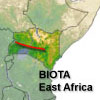Project description |
Although an already significant part of the pilot and second phase of BIOTA, information policy becomes even more important when it comes to the complex task of realising the management plans developed. Apart from the obligatory interchange at the scientific level, local communities have to be informed about forthcoming actions and possible consequences. Decision makers and authorities will take part in all aspects of scheduled implementations. To warrant an easy and quick exchange of systematic information about the transformation at all levels involved, it will be necessary to develop integrative information tools. Assisted by these tools it should be possible to compile the tremendous amount of data into accessible and understandable statements. Key characteristics of the information policy should be compatible with different levels of local and national capacity, needs-driven, created for the mutual benefit of all participants and support decision-making.
Subsequent to the development of scenarios for a sustainable management of biodiversity, the required tools have to be completed and tested. National and regional management authorities and stakeholders will take part in joint planning of respective actions and their implementation. The process will be accompanied by monitoring of the effectiveness of selected applications and the subsequent interchange of feedback information between stakeholders, local communities, management authorities and biodiversity researchers.
Parallel to this evaluation process, it is intended to transfer experiences and results gained from the small scale study model Kakamega Forest to other endangered East African rain forest systems. In connection with GIS tools and time series of past developments as well as a rapid evaluation of socio-economic components, area-specific differences and political priorities, we intent to modify developed management plans according to the area-specific requirements and run equivalent test procedures. To obtain the necessary feedback from included areas, personal capacity building at respective research institutions and management authorities is desired. The increase of information from a series of forest systems will include chances for refinement of management plans in action.
The plans require updating and final development by incorporating and collating data from BIOTA together with the stakeholder generated data. This is especially important because of the newly enacted Forest Act , which better defines the Forest/Community interface. The planning process therefore needs to engage the forest adjacent communities so that they dialogue on future forest reserve management. Given the above, we propose that the management plan be structured along four programmes (Ecological Management, Tourism Management, Community Interface, Forest Reserve Management/Operations). To steer the process we need to reconstitute a core planning team (CPT). The CPT will consist of KWS and FD staff from the HQs and field supported by a BIOTA member. The planning team will involve other stakeholders to discuss in more detail the four programmes and organize the broader consultative process. |






 Go to the WeatherNet
Go to the WeatherNet BIOTA East Africa - Workpackage(s)
BIOTA East Africa - Workpackage(s)